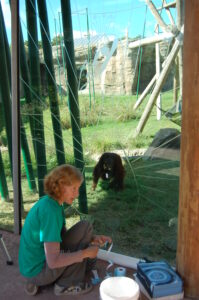Zoo prevents bird deaths by applying tape
We’ve been getting a lot of questions about the “stuff on the windows” at the orangutan and tiger exhibits. So we’ve decided to sit down with Brooke, the Zoo’s Lead Bird Keeper and ask her a few questions.
Question: Hi, Brooke! So, what is that stuff on the windows?
Answer: Hey gang! The window coverings are actually a special ultra-violet tape that we place on the windows to help birds know that there is glass there.

Q: Why does the Zoo do this?
A: When birds are in flight they do not see the glass, unfortunately increasing the amount of bird strikes.
Q: What is a “Bird Strike”?
A: A bird strike is a collision of a bird with a man-made object, like cars, buildings, wind turbines, airplanes – or in our case, exhibit glass.
Q: Why is it important to apply the tape?
A: That’s a very good question! Bird strikes are often fatal. An estimated 100 million to 1 billion birds die annually in just the United States alone due to bird strikes.
Q: Does this affect all birds?
A: Nearly one-third of US bird species are documented victims of preventable collisions. We find that migratory birds and backyard birds are among the most common victims. These include the White-throated Sparrow, Hermit and Wood Thrush, Painted Bunting, Yellow-Rumped Warbler and Ruby-throated Hummingbird.
Q: Why are birds so important anyway?
A: Birds help the world go round! They assist with pollination, seed dispersal and pest control. Plus, they are also beautiful and interesting to watch and study.

Q: So, does the tape actually work?
A: YES! The Virginia Zoo participated in a research project with Old Dominion University and we saw a 66% reduction in bird strikes on windows with the tape! Fall bird migration occurs from September to November. This is the worst time for bird strikes, so the Virginia Zoo keeps the tape is up throughout the season.
Q: That’s terrific! What can we do to help?
A: Use bird tape at home or encourage your work place to apply it as well. The bird tape can be purchased right here in the Zoo’s Gift Shop, and is also available online at the American Bird Conservancy.